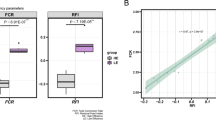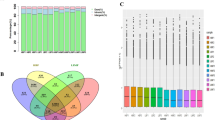Abstract
To study the difference in transcriptome level of fatty acid metabolism pathway in Bamei pork and the difference of pork quality caused by the difference. In this study, Bamei pigs breeding in Huzhu farm of QingHai province were selected as the test object, compared with Gansu Black pigs. Four indexes of nutmeg acid (DX1), palmitic acid (DX2), stearic acid (DX3) and linoleic acid (DX4) were set. The expression profiles of fat metabolism related genes between the two groups samples were analysed by GCMS metabolomics and transcriptomics, then coexpression network analysis were conducted to obtain phenotypic related genes. The results showed that the metabolic levels of DX3 and DX4 were significantly higher than those of other fatty acids. Among these differences, the ENSSSCG00000024681 (G1) and ENSSSCG00000036883 (G2) genes play important regulatory roles in fatty acid metabolism, and the upregulated expression of their gene obviously affects the level of fatty acid metabolism, thereby affecting the quality and taste of pork. In addition, we found that there was a good correlation between the same lines, and the genetic traits of the hybrid lines of Bamei pig and Black pig are more inclined to Bamei pig. In the independent fatty acid metabolism, “Mg2+”and flavin adenine dinucleotide are more active, which plays an important role in energy utilization. Therefore, we can be inferred that the metabolism of stearic acid and linoleic acid are important fatty acids for pork quality. It also further confirms that the research method of combined omics is of great significance for the study of species traits and gene functions.







Similar content being viewed by others

References
Muggleton JM, Kondracki M, Allen R (2000) Spinal fusion for lumbar instability: does it have a scientific basis?[J]. J Spinal Disord 13(3):200–204
Dorni C, Sharma P, Saikia G et al (2018) Fatty acid profile of edible oils and fats consumed in India[J]. Food Chem 238(jan.1):9–15
Teh SS, Voon PT, Ong ASH et al (2016) Incorporation of palmitic acid or stearic acid into soybean oils using enzymatic interesterification[J]. J Oleo Ence 65(9):797–802
FreitasJúnior JE, Bettero VP, Zanferari F et al (2019) Ruminal fatty acid outflow in dry cows fed different sources of linoleic acid: reticulum and omasum as alternative sampling sites to abomasum[J]. Arch Anim Nutr 73(3):171–193
Erukainure OL, Ajiboye JA, Abbah UA et al (2018) Monodoramyristica (African nutmeg) modulates redox homeostasis and alters functional chemistry in sickled erythrocytes[J]. Hum Exp Toxicol 37(5):458–467
Urrutia O, Mendizabal JA, Insausti K et al (2016) Effects of addition of linseed and marine algae to the diet on adipose tissue development, fatty acid profile, lipogenic gene expression, and meat quality in lambs. PLoS ONE 11(6):e0156765
Enser M, Avery NC (1984) Mechanical and chemical properties of the skin and its collagen from lean and obese-hyperglycaemic (ob/ob) mice[J]. Diabetologia 27(1):44–49
Laranjo M, Gomes A, Agulheiro-Santos AC et al (2017) Impact of salt reduction on biogenic amines, fatty acids, microbiota, texture and sensory profile in traditional blood dry-cured sausages[J]. Food Chem 218:129–136
Yan SK, Liu RH, Jin HZ et al (2015) “Omics”in pharmaceutical research: overview, applications, challenges, and future perspectives[J]. Chinese J Nat Med 13(1):3–21
Fiehn O, Robertson D, Griffin J et al (2007) Metabolomics standards initiative (MSI) [J]. Metabolomics 3(3):175–178
Consortium M (2010) The microarray quality control (MAQC)II study of common practices for the development and validation of microarray based predictive models[J]. Nat Biotechnol 28(8):827–838
Xie BB, Yang YD, Ding N et al (2015) Integrate and analyze the precise medical strategy of multiple group data to screen disease targets[J]. Genetics 37(7):655–663
Villar M, Ayllon N, Alberdi P et al (2015) Integrated metabolomics, transcriptomics and proteomics identifies metabolic pathways affected by Anaplasma phagocytophilum infection in tick cells[J]. Mol Cell Proteomics 14(12):3154–3172
Hao Y, Li D, Xu Y et al (2019) Investigation of lipid metabolism dysregulation and the effects on immune microenvironments in pan-cancer using multiple omics data[J]. BMC Bioinform 20(Suppl 7):195
Tan H, Zhang J, Qi X et al (2019) Correlation analysis of the transcriptome and metabolome reveals the regulatory network for lipid synthesis in developing Brassica napus embryos[J]. Plant Mol Biol 99(1–2):31–44
Arshad MS, Sohaib M, Ahmad RS et al (2018) Ruminant meat flavor influenced by different factors with special reference to fatty acids[J]. Lipids Health Dis 17(1):223
Janiszewski P, Murawska D, Hanzal V et al (2018) Carcass characteristics, meat quality, and fatty acid composition of wild-living mallards (Anas platyrhynchos L.) [J]. Poult Sci 97(2):709–715
Meldrum SJ, Li Y, Zhang G et al (2018) Canpolymorphismsinthe fattyacid desaturase (FADS) gene cluster alter the effects of fish oil supplementation on plasma and erythrocyte fatty acid profiles? An exploratory study [J]. Eur J Nutr 57(7):2583–2594
Anders S, Huber W (2010) Differential expression analysis for sequence count data [J]. Genome Biol 11(10):R106
Acknowledgements
This work was supported by the project of Agricultural Product Quality Safety Risk Assessment of China (No. GJFP202001503) and the project of Special funds for basic scientific research operating expenses of public research institutes at the central level (No. 1610322020019).
Author information
Authors and Affiliations
Corresponding author
Ethics declarations
Conflict of interest
These no potential competing interests in our paper. And all authors have seen the manuscript and approved to submit to your journal. We confirm that the content of the manuscript has not been published or submitted for publication elsewhere.
Additional information
Publisher's Note
Springer Nature remains neutral with regard to jurisdictional claims in published maps and institutional affiliations.
Rights and permissions
About this article
Cite this article
Xi, B., Luo, J., Gao, Yq. et al. Transcriptome–metabolome analysis of fatty acid of Bamei pork and Gansu Black pork in China. Bioprocess Biosyst Eng 44, 995–1002 (2021). https://doi.org/10.1007/s00449-020-02468-5
Received:
Accepted:
Published:
Issue Date:
DOI: https://doi.org/10.1007/s00449-020-02468-5



